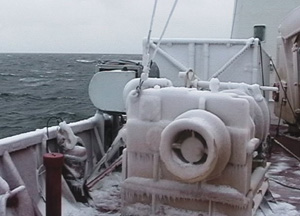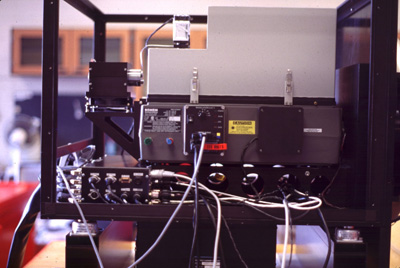Marine-Atmosphere
Emitted Radiance Interferometer
(M-AERI)
This Fourier transform interferometric spectroradiometer measures
spectra in the infrared (3 to 18 µm) with a resolution of 0.5
cm-1. It uses two infrared detectors cooled to 78 K by a Stirling
cycle mechanical cooler to reduce the noise equivalent temperature
difference to levels well below 0.1 K. The radiometric calibration
of the M-AERI is done continuously using two internal black-body cavities,
each with an effective emissivity of >0.998. The mirror scan sequence
includes measurements of the reference cavities before and after each
set of spectra from the ocean and atmosphere.

An M-AERI mounted on the foredeck of the Canadian
Coast Guard Icebreaker Pierre Radisson in the Arctic Ocean, October
2002. |
 |
| The
interior of the M-AERI showing the interferometer (dark gray box)
and Stirling cycle cooler (metal cylinder in a black heat exchanger
on the left). The aft optics are in the light gray enclosure above
the interferometer. |
| The
absolute accuracy of the M-AERI calibration is monitored by episodic
use of a NIST-certified water-bath black-body calibration target (Fowler,
1995; Rice et al, 2003). Residual errors in the MAERI spectral brightness
temperature measurements at temperatures typical of the lower troposphere
are <0.03K. The interferometer integrates measurements over a pre-selected
time interval, usually a few tens of seconds, to obtain a satisfactory
signal-to-noise ratio, and a typical cycle of measurements including
two view angles to the atmosphere, one to the ocean, and calibration
measurements, takes about ten minutes. The absolute accuracy of the
spectral measurements (when expressed as a brightness temperature)
is 20-30 mK, and of the skin SST retrieval is better than 0.1K. The
instrument is described fully by Minnett et al. (2001). |
|
|
|